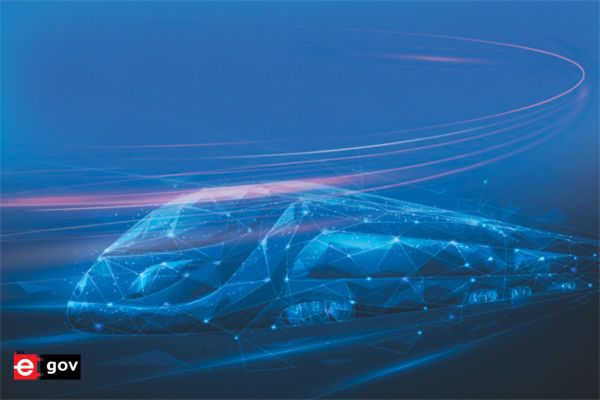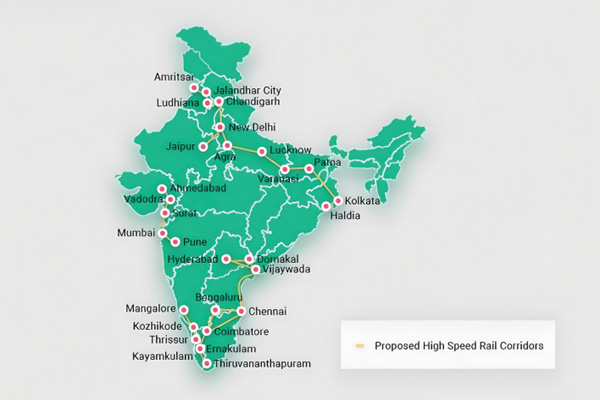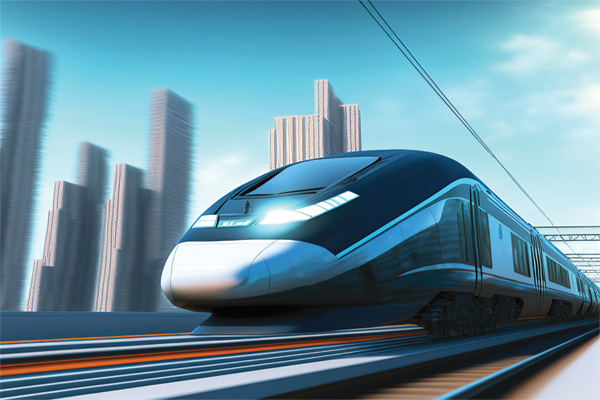
Railway and Metro systems possess intricate technologies, encompassing a diverse array of people, organizations, and technical solutions. To manage such complexity, a viable approach is to employ intelligent computerized systems. Industry 4.0, denoting the fourth industrial revolution, is characterized by astute systems and solutions based on the industrial internet. The transportation sector, particularly railways, has extensively embraced Industry 4.0.
The use of new and emerging technologies is resulting in improved service quality, innovative cost savings, optimized resource utilization, and increased efficiency. Moreover, it has enabled the development of creative services and business models based on the capabilities of the industrial internet and the analytical power of big data.

The comprehensive architecture of big data encompasses cyber-physical systems, the Internet of Things (IoT), and cloud computing, which collaborate to create “Smart Railways.” With the emergence of the Internet of Things (IoT) and Cyber-Physical Systems (CPS), the potential for IoT and CPS in rail transportation is immense, ushering in novel and promising prospects for the industry. IoT refers to the interconnectivity of physical devices, vehicles, buildings, and other items via the Internet, enabling them to gather and exchange data. On the other hand, CPS combines physical and digital systems to create intelligent and autonomous systems. Together, these technologies revolutionize rail transportation by enhancing safety, efficiency, and sustainability.

As the rail industry increasingly incorporates Cyber-Physical Systems (CPSs) to connect its various components, communication technologies introduce a heightened risk of cyber threats targeting these rail-CPSs. Such threats can lead to significant failures with far-reaching consequences. To mitigate this issue, it is crucial to proactively identify, define, and effectively manage the cybersecurity risks associated with rail-CPS implementations.


Source: Invest India
CREATING A DATA-DRIVEN RAILWAY

Railway companies have been investing in data-driven systems that include IoT and Cyber-Physical systems to improve their operations and enhance the passenger experience.
The benefits of IoT in railways are numerous. By collecting and analyzing data in real time, railway companies can improve the safety, reliability, and efficiency of their operations. This can lead to fewer delays, reduced maintenance costs, and improved passenger satisfaction. Cyber-Physical Systems (CPS) are another technology that is becoming increasingly popular in the railway industry.
Considerable effort is required to carry out various tasks related to data collection, management, and service provision to fully benefit from data analytics for improved asset reliability. Here are some key points:
- Establishing a supplier ecosystem equipped with Internet of Things (IoT) capabilities
- Collecting data from different types of assets and providing new equipment and platforms for data collection.
- Exploring the opportunity for managed services through a single service integrator.
- Integrating asset data, operational data, and maintenance data using suitable interfaces.
- Establishing an easy mechanism to exchange asset data throughout the life cycle of assets.
- Utilizing decision modelling and risk analysis tools to identify bottlenecks.
- Generating maintenance alerts for different assets to ensure safe, efficient, and effective railway operations.
- Implementing strategic maintenance planning and creating easily accessible reports for asset information.
- Distributing tablets to field maintainers and enabling direct access to asset data and maintenance requests through the existing Wi-Fi network, thereby eliminating paperwork.
- Indian Railways should absorb and consolidate this extensive data into a national intelligence model that can effectively serve the data- driven railway system in a unified, secure, and cost-efficient manner.
The railway network in India was forecast to become the third largest across the globe in the next five years. Indian Railways was one of the biggest employers in the country. The freight traffic via dedicated freight corridors was projected to increase at a compound annual growth rate of over five per cent by the end of the fiscal year 2022, as per Statista.
UNLEASHING THE POWER OF CONNECTIVITY: THE SMART RAILWAY REVOLUTION
In the realm of rail transportation, a new era of innovation and connectivity is dawning, opening doors to unprecedented opportunities for businesses operating within the industry. With the Indian Railways announcing a staggering Rs. 2.40 lakh crore capital expenditure allocation for the upcoming fiscal year, the government’s resolute commitment to modernize and revamp the railway infrastructure has set the stage for a transformative journey. As the sector embraces digitalization, the integration of Internet of Things (IoT) and Cyber- Physical Systems (CPS) technologies emerges as a driving force behind B2B transformation, reshaping the landscape and propelling businesses towards a connected future.
NAVIGATING THE CHALLENGES OF IMPLEMENTATION
However, the implementation of IoT and CPS in rail transportation presents challenges. One of the primary hurdles is interoperability, as multiple vendors and systems are involved, making seamless integration of IoT and CPS technologies complex. Additionally, cybersecurity poses a substantial concern, given the vulnerability of IoT and CPS systems to cyber-attacks. Ensuring the security and privacy of data becomes imperative for the successful deployment of these technologies in rail transportation.

Notwithstanding these daunting obstacles, the prospective advantages entailed by the incorporation of the Internet of Things (IoT) and Cyber- Physical Systems (CPS) in the field of rail transportation are of such magnanimous magnitude that they simply cannot be disregarded. The industry is already starting to embrace these technologies, and many companies are investing in IoT and CPS solutions.
According to IBEF, Rail infrastructure will see an investment of Rs. 50 lakh crore (US$ 715.41 billion) by 2030.
According to Invest India, As of Feb 2023, 85 per cent of the total Broad- Gauge network has been electrified. With this, Indian Railways has completely electrified six zonal railways and is rapidly progressing towards its target of 100 per cent electrification and becoming the largest green railway network in the world.
SMART TRAINS AND CONNECTED RAILWAYS
With the emergence of autonomous vehicles and improved cargo management, the transportation industry is greatly influenced by the industrial “Internet of Things” (IoT). However, one area that has received less attention is the connected railway. Operating trains at high speeds through tunnels and in extreme weather conditions pose significant challenges for deploying IoT systems. Nevertheless, advancements in networking technology have made the concept of smart trains feasible, offering numerous benefits in terms of transportation of goods, passenger comfort, and enhanced return on investment for operators.
The gradual replacement of traditional infrastructure with train management systems has resulted in interconnected trains functioning as communication hubs. These trains exchange data among themselves and with network control centers, receiving instructions from these centers. Leveraging machine-to-machine communication, along with the assistance of cloud technology, operators can utilize equipment, tracks, and stations more efficiently. This not only leads to improved operational efficiency but also significantly reduces safety risks involved in railway operations.
VISIONARIES LEADING THE WAY
Despite the challenges, visionary companies are already paving the path to a smarter railway ecosystem. Siemens Mobility, a global leader, has developed the Siemens Mobility Operating System (SMOS), a digital platform that seamlessly incorporates IoT and CPS technologies. With SMOS, train operators can optimize routes, reduce energy consumption, and ensure passenger safety, propelling rail transportation into a new era of efficiency and innovation.
Also Read | Driving Digitisation: CRIS’s Role in Modernising Indian Railways
Another pioneering company, Alstom, has harnessed the power of IoT with their innovative solution, TrainScanner. By utilizing sensors to monitor train health and predict maintenance needs, TrainScanner minimizes downtime and maximizes operational efficiency. Additionally, it collects valuable data on passenger behaviour, empowering operators to optimize schedules and create an unparalleled passenger experience.
LOOKING AHEAD: A CONNECTED FUTURE ON THE TRACKS
As the curtain rises on the smart railway revolution, the possibilities seem boundless. The integration of IoT and CPS in rail transportation holds the promise of a connected future, transforming safety standards, boosting efficiency, and promoting sustainability. While challenges persist, the industry is propelled by visionary leaders and cutting-edge solutions that are reshaping the rail transportation landscape. As we embark on this thrilling journey, let us embrace the opportunities that lie ahead, as rail transportation accelerates into the digital age, forging a path towards a smarter, more connected world on the tracks.
Be a part of Elets Collaborative Initiatives. Join Us for Upcoming Events and explore business opportunities. Like us on Facebook , connect with us on LinkedIn and follow us on Twitter, Instagram.
"Exciting news! Elets technomedia is now on WhatsApp Channels Subscribe today by clicking the link and stay updated with the latest insights!" Click here!













